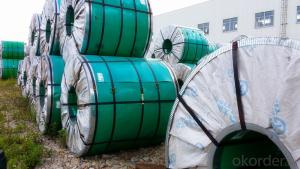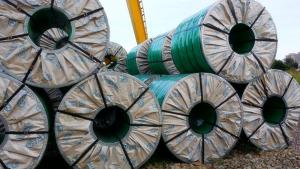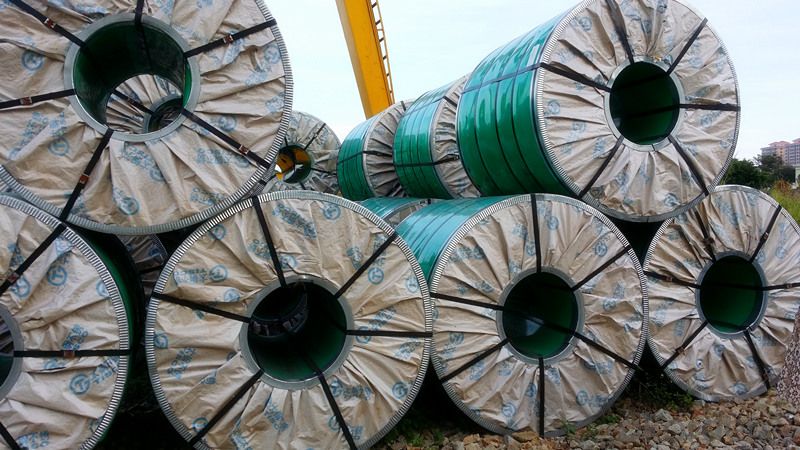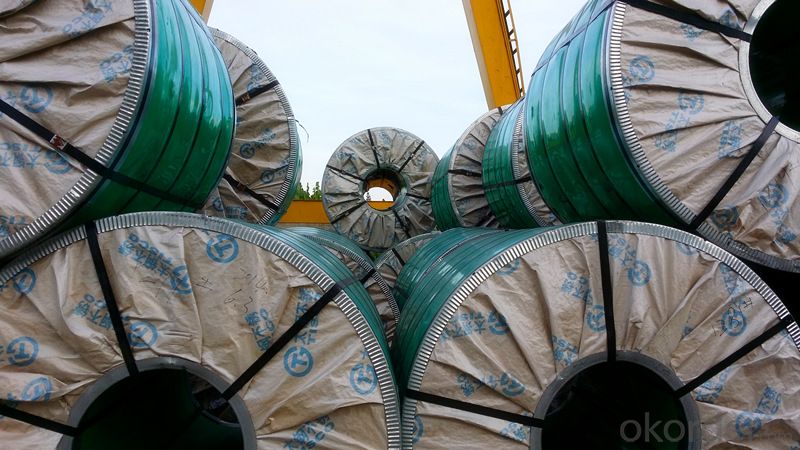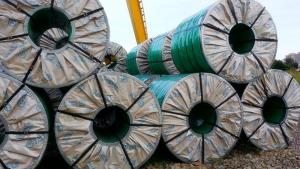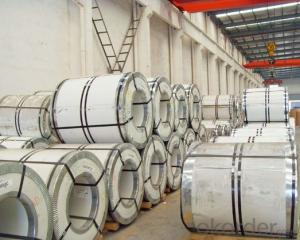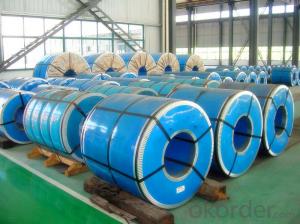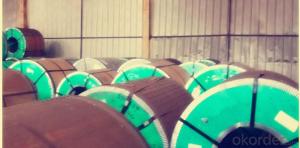Hot Rolled Stainless Steel Coil 430R No.1 Finish
- Loading Port:
- Guangzhou
- Payment Terms:
- TT OR LC
- Min Order Qty:
- -
- Supply Capability:
- 15000 m.t./month
OKorder Service Pledge
OKorder Financial Service
You Might Also Like
Grade: | 400 Series | Standard: | JIS,AISI,ASTM,GB,DIN,EN | Length: | Coil |
Thickness: | 2.5mm,3.0mm, 4.0mm | Width: | 1000mm, 1219mm, 1240mm, 1500mm | Place of Origin: | China Mainland |
Brand Name: | CNBM | Model Number: | 430R | Type: | Coil |
Application: | Element Supports,Stove trim rings,Fasteners,Chimney Liners | Certification: | ISO | Certificate: | ISO9001:2008 |
Surface: | No.1 | Technique: | Hot Rolled | Experience: | About 20 years |
Stock Information: | In stock | Weight per coil: | 18-22 tons | Tolerance: | +/-0.1mm or less |
Model No.: | 430R |
|
|
|
|
Hot Rolled Stainless Steel Coil 430R No.1 Finish
Article | Hot Rolled Stainless Steel Coil 430R |
Grade | 400 series |
Specification | 1m, 1.2m, 1.5m |
Surface | No.1 |
Type | Sheet / Coil |
Width | 1000mm, 1219mm, 1240mm, 1500mm |
Thickness | 2.5mm,3.0mm, 4.0mm |
Brand name | CNBM |
Parking | seaworthy wooden pallets or wooden cases,in 20' or 40' container or as per customers' requirements |
Payment | 30% in advance,70% after shipping, or L/C at sight |
Delivery Time | Stock materials, within7-15 days after received the deposit of T/T or L/C |
Hot Rolled Stainless Steel Coil 430R No.1 Finish
Grade | C | Cr | Si | Mn | Mo | Ni | P | S |
| Max |
| Max | Max |
| Max | Max | Max |
430R | 0.12 | 16.0-18.0 | 0.75 | 1.00 | ----- | 0.6 | 0.04 | 0.03 |
- Q: Can stainless steel strips be used in the semiconductor industry?
- Indeed, the semiconductor industry does employ stainless steel strips. Renowned for its exceptional resistance to corrosion, impressive strength, and enduring nature, stainless steel proves itself as a fitting material for an array of applications within this industry. In the construction of semiconductor equipment, including chambers, wafer carriers, and process tools, stainless steel strips frequently find employment, as they are capable of withstanding unforgiving surroundings and elevated temperatures. Moreover, stainless steel strips may be meticulously designed to meet particular specifications, guaranteeing precision and dependability in semiconductor manufacturing procedures.
- Q: Are 111 stainless steel strips suitable for chemical storage tanks?
- No, 111 stainless steel strips are not suitable for chemical storage tanks. 111 stainless steel is not specifically designed to resist corrosion or withstand the aggressive chemical environments that are typically found in storage tanks. It is important to use stainless steel grades that are specifically designed for chemical storage applications, such as 304 or 316 stainless steel, which have higher resistance to corrosion and chemical attacks.
- Q: Are stainless steel strips recyclable?
- Yes, stainless steel strips are recyclable. Stainless steel is a highly recyclable material and can be reused to manufacture new products.
- Q: Can stainless steel strips be used in contact with food?
- Stainless steel strips, indeed, find utility when they come into contact with food. Owing to its non-reactive characteristics, corrosion resilience, and sturdy build, stainless steel stands as a favored option for food-related purposes. It refrains from releasing any detrimental substances into the food and wards off staining, thereby ensuring a secure and sanitary material for food handling, storage, and presentation. Frequently, stainless steel strips find employment in commercial kitchens, food processing facilities, as well as household appliances like refrigerators, sinks, and cookware.
- Q: What is the maximum length available for stainless steel strips?
- The maximum length available for stainless steel strips can vary depending on the manufacturer and the specific requirements of the customer. However, in general, stainless steel strips can be produced in lengths ranging from a few inches to several feet. Some manufacturers may be able to produce even longer strips, depending on their capabilities and equipment. It is important to consult with the manufacturer or supplier to determine the maximum length available for stainless steel strips that meet your specific needs.
- Q: Can 111 stainless steel strips be polished to a mirror-like finish?
- It is indeed possible to achieve a mirror-like finish on 111 stainless steel strips. However, the key factors that determine this outcome are the quality of the stainless steel strips and the polishing method employed. Stainless steel possesses inherent qualities such as a smooth surface and resistance to corrosion, which enable it to be polished to a high shine. Nevertheless, attaining a mirror-like finish necessitates a meticulous polishing process that involves several stages of abrasive materials and polishing compounds. By employing the appropriate equipment and technique, it becomes feasible to polish 111 stainless steel strips to a mirror-like finish, resulting in an exceptionally reflective and aesthetically pleasing surface.
- Q: Are stainless steel strips corrosion-resistant?
- Stainless steel strips possess corrosion-resistant properties. They belong to a category of steel alloys that possess a minimum of 10.5% chromium. This chromium content enables the formation of a thin protective layer, known as a passive film, on the steel's surface. The passive film exhibits remarkable resistance against corrosion, rendering stainless steel strips suitable for numerous applications that demand corrosion resistance. Moreover, stainless steel also incorporates additional elements like nickel and molybdenum, which further augment its resistance to corrosion. Consequently, stainless steel strips exhibit exceptional durability and can endure exposure to moisture, chemicals, and other corrosive surroundings without succumbing to rust or corrosion.
- Q: Are stainless steel strips suitable for architectural roof cladding?
- Yes, stainless steel strips are suitable for architectural roof cladding. Stainless steel is a durable and corrosion-resistant material, making it ideal for outdoor applications such as roof cladding. It can withstand harsh weather conditions, including rain, snow, and UV radiation, without deteriorating or losing its aesthetic appeal. Additionally, stainless steel is available in various finishes and colors, allowing architects to choose from a wide range of options to achieve the desired design aesthetic. Its versatility, strength, and low maintenance requirements make stainless steel strips an excellent choice for architectural roof cladding.
- Q: How do stainless steel strips perform in seawater environments?
- Stainless steel strips are highly resistant to corrosion and perform exceptionally well in seawater environments. Due to their composition, which includes a significant amount of chromium, stainless steel strips form a passive oxide layer on their surface that acts as a protective barrier against corrosion. This oxide layer prevents direct contact between the steel and the corrosive elements present in seawater, such as salt and moisture. Furthermore, stainless steel strips exhibit excellent resistance to pitting and crevice corrosion, which are common forms of corrosion in marine environments. This resistance is primarily attributed to the high levels of chromium and nickel present in stainless steel. These elements enhance the steel's ability to withstand the aggressive nature of seawater, ensuring its durability and longevity. Stainless steel strips also have the advantage of being highly versatile and adaptable, making them suitable for various applications in seawater environments. They can be easily formed, welded, and fabricated into different shapes and sizes, providing flexibility in design and construction. Overall, stainless steel strips are an excellent choice for use in seawater environments due to their exceptional corrosion resistance, durability, and versatility. They offer long-lasting performance, minimal maintenance requirements, and can withstand the harsh conditions associated with marine applications, making them a reliable and cost-effective solution.
- Q: How do you determine the mechanical properties of a stainless steel strip?
- To determine the mechanical properties of a stainless steel strip, various testing methods can be employed. These include tension tests to measure the strip's ultimate tensile strength, yield strength, and elongation. Hardness tests can be conducted to determine the strip's resistance to indentation or scratching, while impact tests can assess its ability to withstand sudden forces. Additionally, bending tests can help determine the strip's flexibility and ductility. Overall, a combination of these tests provides a comprehensive understanding of the mechanical properties of a stainless steel strip.
Send your message to us
Hot Rolled Stainless Steel Coil 430R No.1 Finish
- Loading Port:
- Guangzhou
- Payment Terms:
- TT OR LC
- Min Order Qty:
- -
- Supply Capability:
- 15000 m.t./month
OKorder Service Pledge
OKorder Financial Service
Similar products
Hot products
Hot Searches
Related keywords
